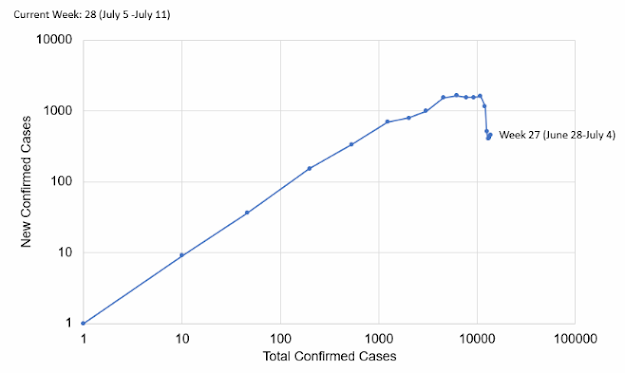Trump Cannot Have It Both Ways
Community transmission of COVID-19 needs to be arrested first if K-12 schools are to reopen this coming September. It is more than a month away and plenty can be done now to halt the spread of the virus. If parents wish their children to attend school this coming school year than all effort must be exerted to stop the coronavirus. Wearing masks when social distancing of six feet is not possible needs to be faithfully followed. Those who are travelling must adhere to self-quarantine for two weeks when they return home. Bars and churches should remain closed. Gatherings of more than 10 people in limited space should be avoided. Everyone must continue to practice good hygiene. Fairfax county is in a good position to control the virus at this point as these measures appear to be working quite well. While we debate on how schools should operate, we need to focus on how to halt community transmission. Trump cannot force schools to reopen without supporting measures that halt the spread of the virus. We, however, should not be obsessed with what Trump does or thinks, because we can still make children attending their schools a reality in our community.
 |
| Above copied from Fairfax County Health Department |
Based on the current situation, Fairfax county is in the right trajectory. The community however must continue with its vigilance. We must because K-12 schools need to return to in-person classes. Achievement gaps are only going to become as deep as a canyon with virtual classes. Children from low-income families simply do not have the resources necessary for a successful online learning. These children are in homes where both parents maybe juggling two to three jobs to make ends meet. And in these homes, older siblings are given the task to take care of the younger ones. There is simply no time and space for these children to study at home even if laptops and access to the internet are provided.
A former director for the US Centers for Disease Control and Prevention, Thomas R. Frieden, and two former secretaries of education, Arne Duncan and Margaret Spellings, have outlined steps necessary to open schools in-person this coming Fall. They also emphasized that the work must start with the community first. Transmission must be controlled now. Again, with current numbers, Fairfax county is in good shape.
 |
| Above copied from Fairfax County Health Department |
Once more, those measures are: Wearing masks when social distancing of six feet is not possible needs to be faithfully followed; Those who are travelling must adhere to self-quarantine for two weeks when they return home; Bars and churches should remain closed; Gatherings of more than 10 people in limited space should be avoided; And everyone must continue to practice good hygiene.
If we follow the above steps then we can proceed to the recommended eight steps to reopen school:
- First, shield the most vulnerable. Children, older staff, and those who have underlying health conditions that put them at high risk should not return to school in person unless there is little or no community transmission; the school system should enable them to participate remotely to the greatest extent possible.
- Second, reduce risk wherever possible. Large in-person student assemblies will be out. Cafeterias may need to close, with students instead eating in classrooms. On-site food preparation may be replaced by prepackaged meals and disposable dishware. And schools can reduce the number of surfaces touched by multiple people, for example by keeping hallway doors open.
- Third, keep the virus out. Schools should forbid nonessential visits and require everyone who enters the school—not only students and staff but also parents, delivery people, and maintenance workers—to wash their hands (or apply hand sanitizer) and wear a face mask. Families must understand that their children should not go to school when sick.
- Fourth, wear a mask. Students, teachers, and staff should all wear masks throughout the school day, although this may be challenging for younger children.
- Fifth, reduce mixing among students and staff. Divide students into smaller cohorts, or pods, that stay together throughout the day, rather than mixing and re-forming different class units.
- Sixth, reduce occupancy, especially indoors. Classrooms may need to operate at reduced capacity to provide increased physical distance. Schools can alleviate overcrowding by moving to a split-shift schedule (incorporating morning and an afternoon session) or by alternating students between in-person and remote learning.
- Seventh, implement new health and safety protocols, such as more frequent and thorough cleaning and disinfecting, including of buses. Hand-washing and sanitizing stations should be installed; their use should be required.
- Eighth, prepare for cases. Despite precautions, there will inevitably be coronavirus cases at schools. Schools must function as if the virus could arrive at any moment, and operate so that they can reduce transmission and provide ongoing education when it occurs.
By following the above steps, the schools not only become a lot safer, but also add to our tools that can control the spread of coronavirus. These measures help in monitoring the health of the community. Good practices can be taught and encouraged in an educational setting. Thus, we not only are able to send our children to schools, but also help in eradicating SARS-CoV-2. This is the only way we can have both ways.
Comments
Post a Comment